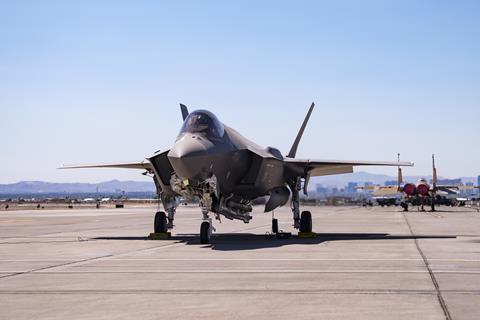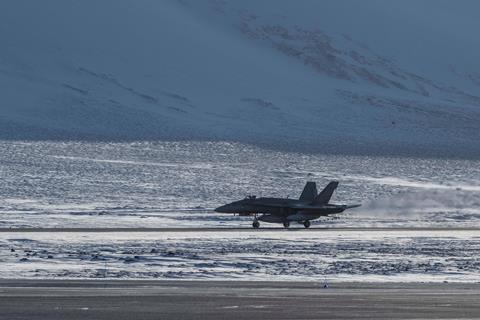Canada has finalised an agreement to purchase Lockheed Martin F-35 stealth fighters, cementing its place in the bloc of 17 nations committed to fielding the advanced jet.
The Canadian government and Lockheed on 9 January said they have reached an agreement covering 88 F-35As at a price of C$19 billion ($14.2 billion).

“This is an important milestone in the significant process to purchase modern fighter jets for the Royal Canadian Air Force and an example of an open, fair and transparent competitive procurement,” says Helena Jaczek, Ottawa’s minister overseeing public procurement.
While officials in Ottawa selected the F-35 in March 2022 to be the country’s new primary fighter platform, the government had been engaged in final negotiations with Lockheed over delivery terms.
The 88 F-35As will replace the Royal Canadian Air Force (RCAF) fleet of Boeing F/A-18 Hornets, currently numbering 76 aircraft, according to Ottawa. Canada also purchased an additional 18 F-18s from Australia to supplement its CF-18 fleet.
The government anticipates receiving the first F-35A in 2026, with the RCAF expected to achieve full operational capability with the jets between 2032 and 2034.
“We are committed to ensuring that our current and future aviators have the most-advanced equipment possible,” says Canadian defence minister Anita Anand. “Canada requires a fighter fleet to contribute to the safety and security of Canadians and protect the sovereignty of one of the largest expanses of airspace in the world.”
Canada is one of the original eight F-35 programme participants that contributed funding to develop of single-engined fighter.
However, Ottawa held a competition under its Future Fighter Capability Project to chose between the F-35 and Saab’s Gripen E, which Saab ultimately lost. The Swedish firm’s Canadian subsidiary in October voiced opposition to the negotiations with Lockheed, saying the terms should have been included in Lockheed’s bid package.
The government rebuffed those claims, telling FlightGlobal in October that the negotiations were part of the “finalisation phase” laid out in its original bid solicitation.
“During this phase, the top-ranked bidder must successfully demonstrate that a resulting contract would meet all of Canada’s requirements and outcomes, including value for money, flexibility, protection against risks, and performance and delivery assurances, as well as high-value economic benefits for Canada’s aerospace and defence industry,” Public Services and Procurement Canada said at the time.
Lockheed had declined to address the Saab claims directly, instead describing the F-35 as “the most-advanced, most-survivable, best-value fighter to replace the Royal Canadian Air Force CF-18 fleet”.

Following the 9 January announcement, Lockheed says F-35s will strengthen Canada’s operational capability with allies and be a “cornerstone for interoperability” with NATO and the joint US-Canada North American Aerospace Defense Command (NORAD).
“The selection of F-35 strengthens allied airpower in Canada, North America and around the world,” says Bridget Lauderdale, F-35 programme general manager for Lockheed.
The C$19 billion F-35 order comes on the heels of a C$40 billion package to modernise and enhance defence capabilities and infrastructure across the Canadian Arctic over the next 20 years. That effort, in conjunction with a similar effort from Washington, includes new tracking radars and more aerial refuelling aircraft for the RCAF.
Ottawa also plans to launch a revamped pilot training programme, known as Future Aircrew Training, to better prepare aviators to fly advanced aircraft like F-35s and to operate the array of onboard sensors needed for modern air combat.
One outstanding question will be a capability of the F/A-18 that the F-35A cannot replace: tail-hook landings.
The F-18, originally designed for maritime operations from an aircraft carrier, has the ability to land using a tail hook and arresting wire. The RCAF and US Air Force recently demonstrated the value of this capacity on land at Thule air base in Greenland, where RCAF F-18s landed during winter conditions with assistance of a mobile arresting wire system.
The base, which lies well north of the Arctic Circle, had previously not been able to support fighter operations during winter months. The new capability marks a substantial increase in high northern air power for NORAD and NATO.
However, unlike F/A-18s and F-35C carrier variants, F-35As lack the tail hook capability and structural reinforcements needed for arresting-wire landings. The type can instead be equipped with a parachute braking system modification.
Story updated on 9 January to note Canada’s purchase of Australian F-18 fighters.


























